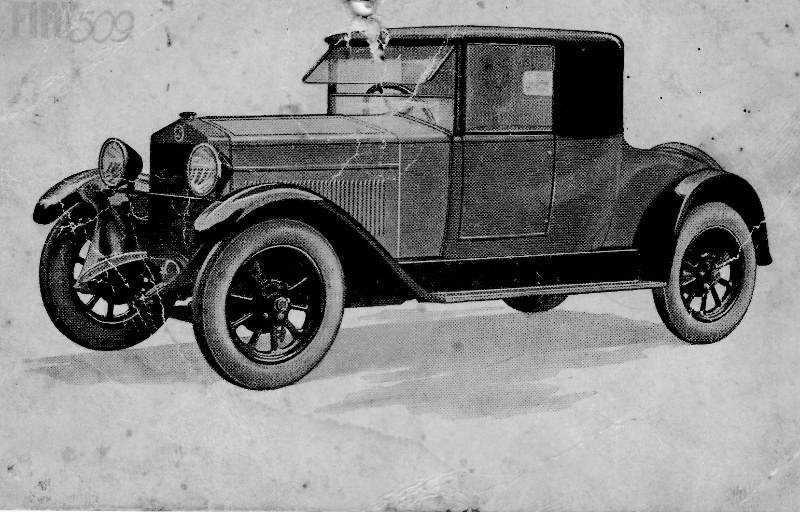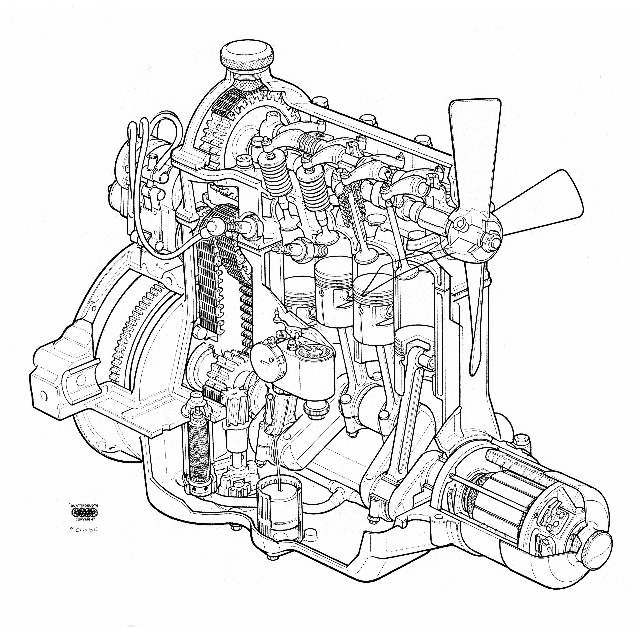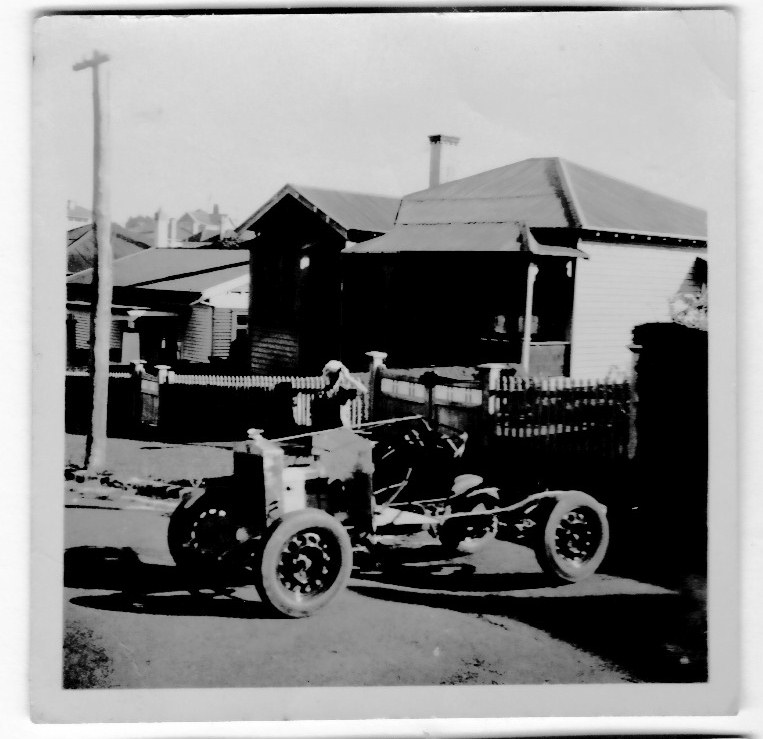-
World Champion

Vintage Fiat 509 Special - a story - Part One.
Preamble ; " Having seen the " Ford Ten special built by Gordon Brown. His efforts encouraged Jock Aitken and others to follow on with the theme he introduced. He was certainly way ahead of Collin Chapman. LOL
A magazine article covering the car inspired me to build a special in order to take up motor sport, and I too used a modified Ruckstell rear axle from a Beauty Model T Ford, in order to overcome the disadvantage of a wide ratio three speed gear box. The article mentioned Gordon fitting a makeshift grader blade to the front of the car in order to level his newly acquired house section.
In those days we were all short of money and few could afford more than one car. When first built the car was used for general purposes as well as motor sport. It had weather protection and as you can see proper doors. At the time import controls meant that there were just a couple of new MG TD in the club and the Ford Ten light weight specials showed them the way at less than half the cost.
"
" I was around at the time and was particularly interested in Gordon Brown’s Ford Ten special as I also utilised a Ruckstell rear end in my Fiat Special "
The story of the Fiat 509 Special.
A photo of an Original Car. a Fiat 509 Tourer.

The story Part One ;
" Shortly after WW2, having secured a drivers license at the age of 15 years, an absolutely burning desire to own a sports car and to do some motor racing became an obsession. My sport had been competitive cycle racing and prior to school I was well into a Meccano sets and later building radios and electrical stuff. Sport and technology therefore ran hand in hand.
A bike ride out to an amateur motor race meeting held at a disused wartime airfield, really set my brain on fire. By hook or by crook I would acquire a suitable car. I could feel the wind in my hair and the feel of an engine in place of handlebars and peddles. It was rather odd that motorcycles never tickled my fancy.
I had picked up a book “Specials” by john Bolster of “Bloody Mary” fame and also a sports car magazine had appeared describing an interesting Ford Ten Special, cheaply built close by. Cycle racing was out and racing sports cars was in.
The theme in those days involving a special was dictated by an absolute scarcity of funds and the lack of obtainable new components. Of necessity, things had to be kept simple. Personally my tool kit was meagre not even a socket set. Only tube spanners scrounged from car tool kits and only a single Crescent and old right angle shifters were on hand. A power tool was a dream. I swapped a record playing amplifier which I had built, for a few extra hand tools and this helped a bit. What I did have, was an eggbeater hand drill, a carpenters brace and a few drill bits, plus a hacksaw.
A couple of specials had been built locally using a suitable available chassis fitted with a Ford Ten engine and these were leaving the only sports cars then on hand for dust. The pre-war models, including the MG brigade were well and truly out gunned on a power to weight basis. After selling a couple of racing push bikes I had one hundred pounds odd. My head and heart were pounding, but what could I do?
I had read all the classic stuff about overhead cams, hemispherical combustion chambers, inlet and exhaust systems etc. A Ford Ten engine was beyond my pocket and what's more did not appeal. Kept searching the papers. Fiat 509, 1927, two seat tourer, not running, unregistered, good for parts, NZ 65 pounds.
Looked up the specs. Overhead cam, close to the 1,100 cc class limit. Very pretty little engine with not an external drive in sight. The generator was driven from the front of the crankshaft and the fan directly from the single overhead camshaft. I was a gonna. Could not hold myself back.
Dragged it home. Dad’s car remained outside for a few days while I tore off the body an sent it to the tip. Dad complained, found space at a friends house. His dad complained. Moved it to my grandmothers small garage some mile and a bit from home. Discovered that the wheels were for beaded edge tyres, bugger. Cycled there and back at every opportunity.
Pulled the old girl to pieces, stood and looked at the bits rather soulfully, but never the less hopefully. What had I done? Ouch! No power to the shed but at home I had a length of telephone cable from a war assets radio I had acquired. Naughty but practical. No bench or vice. First off I cleaned and painted the chassis, all the time with grandiose thoughts propelling me forwards. Would have liked to shorten the wheelbase, but that was not on.
My head spun and my thoughts full-time were devoted to my racing sports car. I frequented a wreckers yard operated by quite a character “Merv. Hardy” and his helper “Gerry Matherson”. These guys had raced cars prior to the war and became my stalwart advisers. Merv. had a Ford T Frontenac racing car in his yard and Gerry was restoring it when time allowed. Gerry had owned and raced locally a quite famous classic Indianapolis Miller. His advice ---- “cam and com is the way to go”.
Cam grinding was out of the question but what the hell. The old 509 had the single central OHC operating the valves via short rockers. I had the rounded ends built up lengthened and ground flat, Bingo.
Merv. rented an extensive old building, no longer existing. The roof leaked and parts were simply strewn about as cars became dismantled. Merv. --- “over there in the corner, under all that crap you will find a Fiat 509 engine”. He had no book of inventory, but with his vibrant old brain none was needed. “Yeh know they used to race those things” he said. “Bloody great little engine, getting them breathing was a problem”. After some digging I found the engine and it tuned out to be from a 1926 Fiat 509, whereas I had identified mine as being a year later 509A, and this turned out to be very significant.
I discovered that the earlier model had the single carburettor located low down on the inlet side of the block, with the inlet passage cast within the block and siamised to exit the block and enter the head as two passages. Here these were again siamised towards the four inlet valves. I became exited. The later model which I possessed had the carburettor shifted to the hot side of the engine with a separate inlet manifold combined with the exhaust. This fed into two passages arranged within the head, so as to connect with the as previously arranged siamised ports.
This change had obviously been made due to problems experienced during cold weather and a sad blunder it would appear. However this suited Trevor. He put the earlier head on his engine which did not have the upward passages in the block, leaving the two passage junctions remaining within the head blanked off. These acted as plenums to be opened up so as to directly fit a pair of carburettors on the cold side of the engine. As a result he very happy to have the sort after classic set up. "
Photo - line drawing of the Engine of a Fiat 509

The Car with the body removed ;

Part two to follow;
Last edited by Roger Dowding; 05-20-2020 at 03:40 AM.
Reason: 1,100 cc ###47
 Posting Permissions
Posting Permissions
- You may not post new threads
- You may not post replies
- You may not post attachments
- You may not edit your posts
-
Forum Rules






 Reply With Quote
Reply With Quote